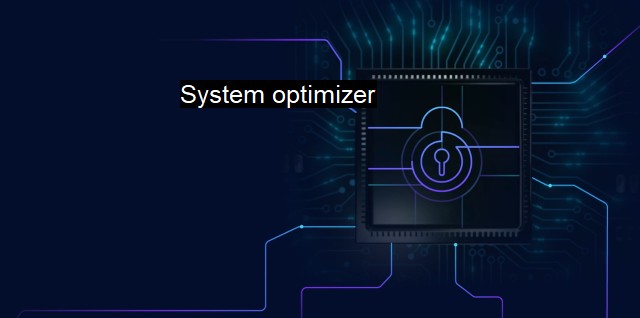What is System optimizer?
Boosting Cybersecurity: The Role of System Optimizers in Protecting Against Threats and Improving Computer Performance
System optimizer, as the name suggests, is a type of software tool designed to optimize overall computer system performance. This general concept bears direct relation to cybersecurity and antiviruses, drawing on the grounds that an efficient, well-maintained system stands a better chance against breaches and various other cyber threats.A system optimizer comes with a broad range of features, helping it to take up multiple roles at once. It targets numerous aspects that combine to determine a computer system's overall performance. For instance, a system optimizer searches for junk files, unused applications, fragmented pieces of data, invalid registries, and many more. By resolving these critical issues, a system optimizer enhances the speed and efficiency of the system, contributing significantly to facilitate a smoother user experience.
Now, shifting our focus to cybersecurity, below, we unravel how a system optimizer comes into the picture. In today's interconnected digital world, the threat of viruses, malware, ransomware, or spyware is omnipresent. These daunting digital threats can wreak havoc on computational systems, affecting their performance and efficiency and possibly stealing, altering, or deleting crucial data.
System optimizers come equipped with tools that proactively nip these threats in the bud, ensuring uninterrupted computer operations. One of the major features that most system optimizers come packed with is an antivirus scanner. Most viruses, malware, or other types of cyber threats leave behind a trail or make changes to certain parts of the system. Through these changes, these threats can harm or take control of the system, posing a significant security risk.
a system optimizer continuously scans the system, red-flagging these changes and dealing with viruses at the earliest. By deleting infected or suspicious files, or isolating them, the system optimizer ensures your computer stays safe, while its performance stays unhindered.
Some system optimizers go one step further, enhancing cybersecurity by doing a high-level cleanup that includes deleting temporary files, browser history, and cookies. These are common places where malware may thrive, and this action significantly decreases the chances of a cyber attack.
Whilst some predatory websites or apps might experience flare-ups while trying to install undesired, often malicious software, sometimes disguised as toolbars or free anti-virus scanners, reputable system optimizers thwart this attempt efficiently by flagging this kind of software.
It is pertinent to note that a system optimizer isn't a standalone cyber defense mechanism. They are indeed powerful tools, but for comprehensive cybersecurity, they should be hitched along with other mechanisms such as VPNs, firewalls, regular software updates, and strong passwords. It waters down to an analogy that having a system optimizer and an antivirus is not about choosing one over the other. Instead, they complement each other, collectively constituting an expansive web of overall system protection.
Other key functions of a system optimizer can include restoring the dropped speed of your Internet connection, improving gaming experience by optimizing systems for play, fixing mystical errors, crashes and freezes, updating drivers, and a lot more.
To summarize, a system optimizer is undeniably a beneficial tool to have in both enhancing system performance and, along with an antivirus, fortifying cybersecurity defenses. A good system optimizer should be able to smartly take intensive care of your system as well as actively protect it from threats, thereby making a compelling argument for its worthwhileness in every computer system. relying solely on them would be imprudent; a comprehensive approach to cybersecurity, which takes into account a multi-faceted defense system, is indispensable to navigate safely and effectively through the digital world.

System optimizer FAQs
What is a system optimizer in cybersecurity and antivirus?
A system optimizer is a software that helps improve the performance of a computer system by optimizing its settings, freeing up disk space, and fixing potential errors. In cybersecurity and antivirus, system optimizers can also help to identify and remove potential security threats, thereby enhancing the overall security of a computer system.How does a system optimizer work in cybersecurity and antivirus?
A system optimizer in cybersecurity and antivirus works by scanning a computer system for potential errors, security threats, and performance issues. Once these issues have been identified, the optimizer then takes steps to fix them, such as deleting unnecessary files, cleaning up disk space, updating outdated software, and removing malicious viruses or malware. This helps to ensure that a computer system runs smoothly, efficiently, and securely.What are some benefits of using a system optimizer in cybersecurity and antivirus?
Using a system optimizer in cybersecurity and antivirus can provide several benefits, including: 1. Improved computer performance and speed 2. Enhanced system security and protection against viruses and malware 3. Increased storage space by deleting unnecessary files and programs 4. Reduced risk of system crashes or data loss 5. Better overall user experience by optimizing settings and preferences.What are some examples of popular system optimizers in cybersecurity and antivirus?
Some popular system optimizers in cybersecurity and antivirus include: 1. CCleaner 2. Advanced SystemCare 3. Glary Utilities 4. AVG PC TuneUp 5. Iolo System Mechanic These tools are designed to help users optimize their computer systems for improved speed, security, and performance.| | A | | | B | | | C | | | D | | | E | | | F | | | G | | | H | | | I | | | J | | | K | | | L | | | M | |
| | N | | | O | | | P | | | Q | | | R | | | S | | | T | | | U | | | V | | | W | | | X | | | Y | | | Z | |
| | 1 | | | 2 | | | 3 | | | 4 | | | 7 | | | 8 | | |||||||